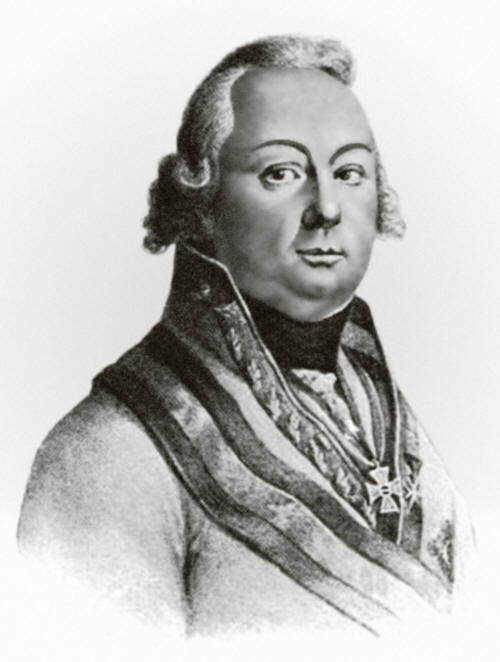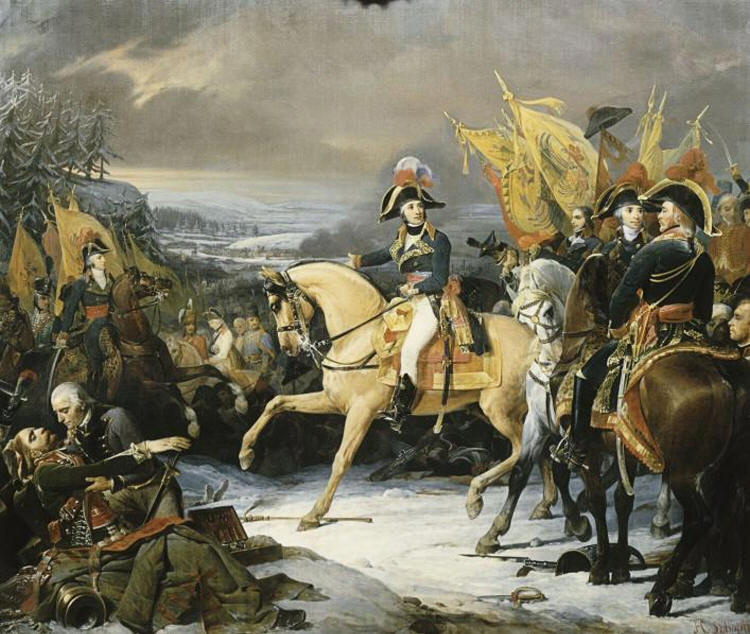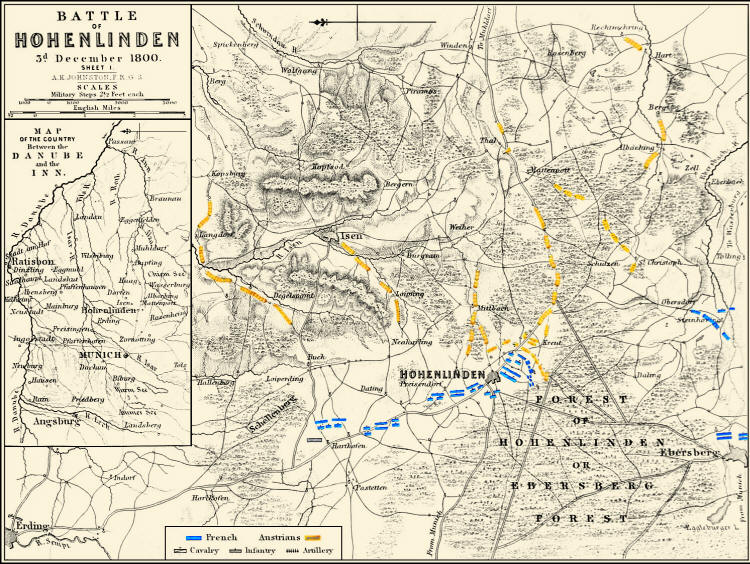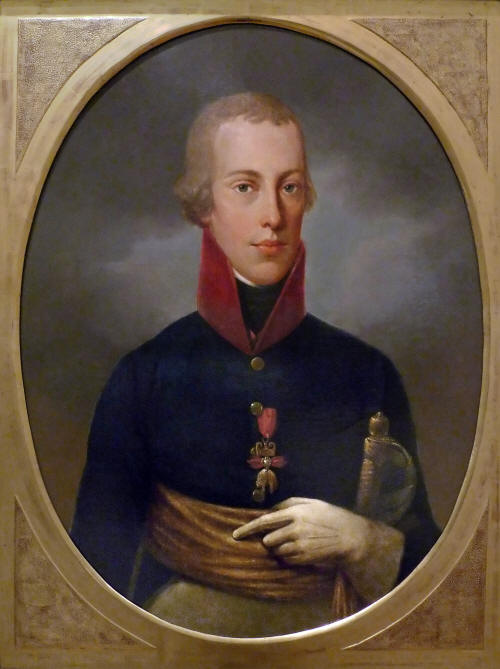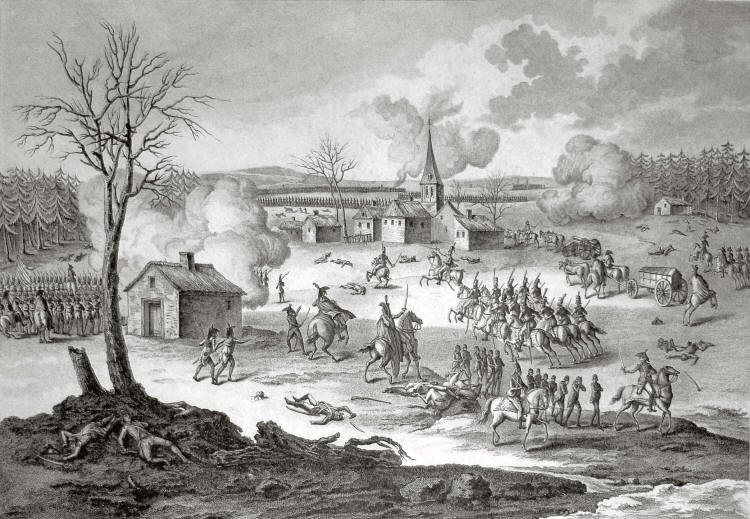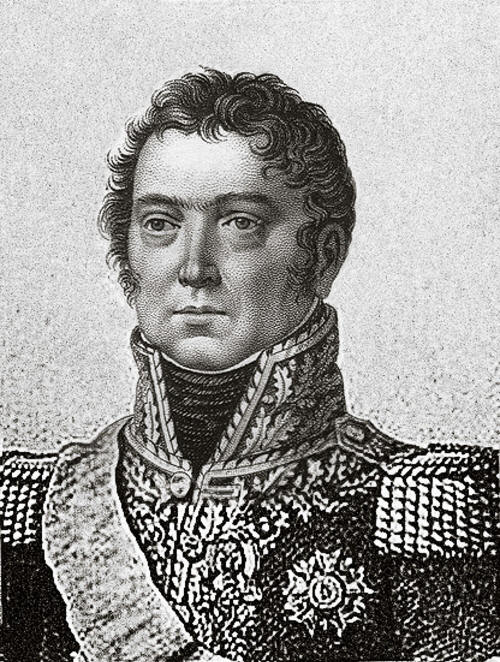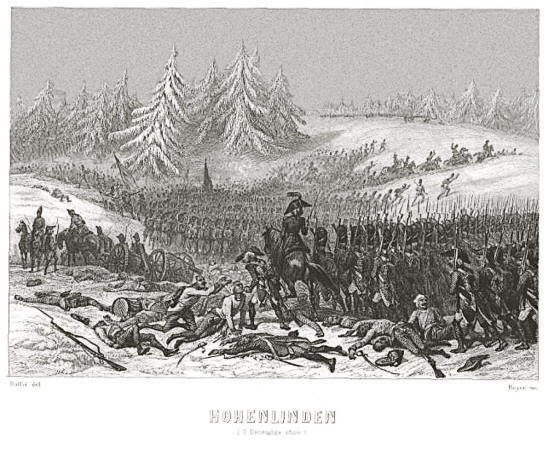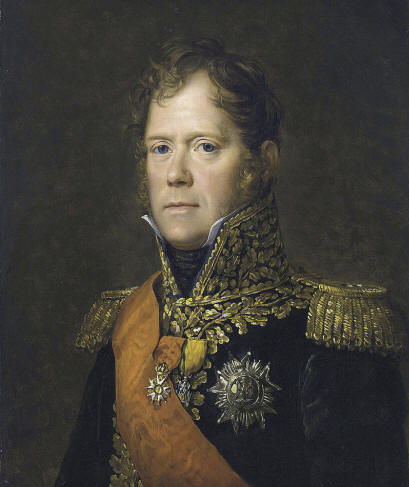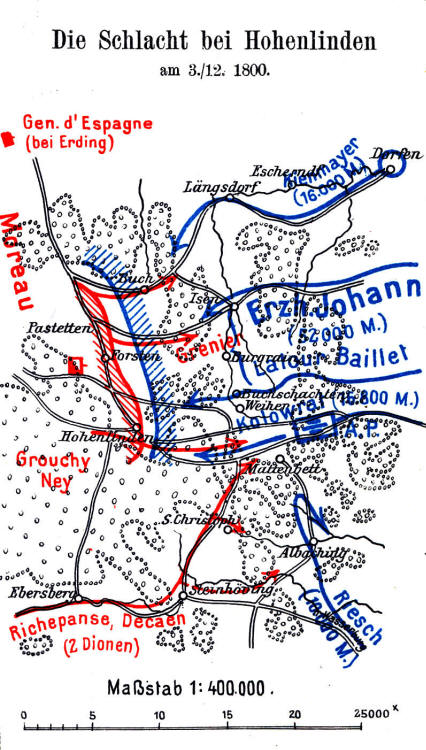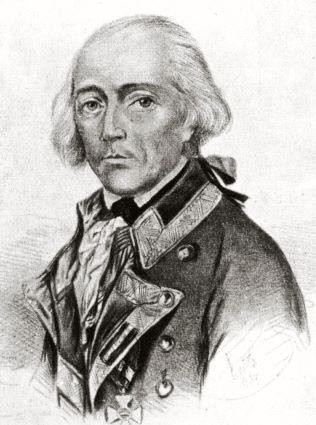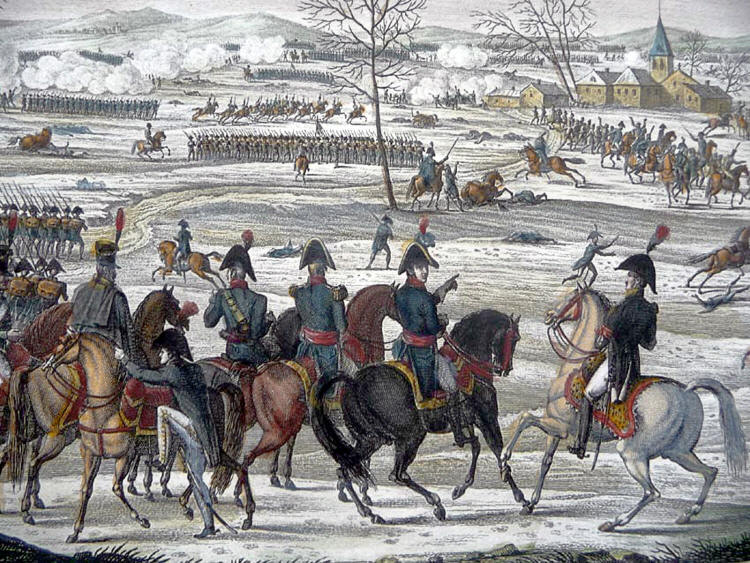|
The Battle of Hohenlinden was
fought on 3 December 1800 during the French Revolutionary Wars.
A French army under Jean Victor Marie
Moreau won a decisive
victory over the Austrians and Bavarians led by Archduke John of
Austria. After being forced into a disastrous retreat, the
allies were compelled to request an armistice that effectively
ended the War of the Second Coalition. Hohenlinden is 33 km east
of Munich in modern Germany.
General of Division (MG)
Moreau's 56,000 strong army engaged
some 64,000 Austrians and Bavarians. The Austrians, believing
they were pursuing a beaten enemy, moved through heavily wooded
terrain in four disconnected columns. Instead,
Moreau ambushed
the Austrians as they emerged from the Ebersberg forest while
launching MG Antoine Richepanse's division in a surprise
envelopment of the Austrian left flank. Displaying superb
individual initiative,
Moreau's generals managed to encircle and
smash the largest Austrian column.
This crushing victory, coupled with First Consul Napoleon
Bonaparte's victory at the Battle of Marengo on 14 June 1800,
ended the War of the Second Coalition. In February 1801, the
Austrians signed the Treaty of Lunéville, accepting French
control up to the Rhine and the French puppet republics in Italy
and the Netherlands. The subsequent Treaty of Amiens between
France and Britain began the longest break in the wars of the
Napoleonic period.
Background
Archduke John-Baptist
From April to July 1800,
Moreau's army drove the Austrian army of Feldzeugmeister Pál
Kray from the Rhine River to the Inn River with victories at
Stockach, Messkirch, and Höchstädt. On 15 July, the combatants
agreed to an armistice. Realizing that Kray was no longer up to
the task, Emperor Francis II removed him from command. The
Austrian chancellor Johann Amadeus Francis de Paula, Baron of
Thugut first offered Archduke Ferdinand Karl Joseph of
Austria-Este and Archduke Joseph, Palatine of Hungary command of
the army but both declined. Because his brother, the capable
Feldmarschall Archduke Charles, Duke of Teschen, also refused
the command, the emperor appointed another brother, the
18-year-old Archduke John. Clearly, the inexperienced youth
could not cope with this enormous responsibility, so the emperor
nominated Franz von Lauer as John's second-in-command and
promoted him to Feldzeugmeister. John was directed to follow
Lauer's instructions. To further complicate the clumsy
command structure, the aggressive Oberst (Colonel) Franz von
Weyrother was named John's chief of staff.
The armistice was renewed in September but lapsed on 12
November. By this time, Weyrother had convinced John and Lauer
to adopt an offensive posture. Weyrother's plan called for
crushing the French left wing near Landshut and lunging south to
cut
Moreau's communications west of Munich. After a few days of
marching, it became obvious that the Austrian army was too slow
to execute such an ambitious plan. So Lauer convinced the
archduke to convert the enterprise into a direct attack on
Munich. Even so, the sudden advance caught
Moreau's somewhat
scattered French forces by surprise and achieved local
superiority.
In the Battle of Ampfing on 1 December, the Austrians drove back
part of General of Division Paul Grenier's Left Wing. The
defeated French managed to inflict 3,000 casualties on the
Austrians while only suffering 1,700 losses. Yet, when the
Austrian leaders found that Grenier evacuated Haag in Oberbayern
the next day, they became ecstatic. Archduke John and Weyrother
overrode Lauer's cautious counsel and launched an all-out
pursuit of an enemy they believed to be fleeing. However,
Moreau decided to stand and fight, deploying his army in open
ground near Hohenlinden. To approach his position, the
Austro-Bavarians had to advance directly west through heavily
wooded terrain.
Plans
For more details on the French
and Austrian army organizations at the Battle of Hohenlinden,
see Hohenlinden Order of Battle.
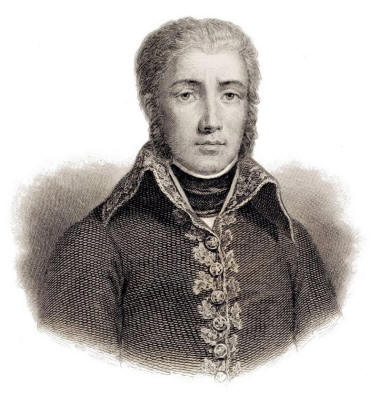
Jean Victor Moreau
Moreau's main defensive
position consisted of four divisions facing east. From north to
south, these were commanded by General of Division Claude
Legrand (7,900), General of Brigade Louis Bastoul (6,300),
General of Division Michel Ney (9,600) and General of Division
Emmanuel Grouchy (8,600). The divisions of Legrand, Bastoul and
Ney belonged to Grenier's corps.
Moreau held 1,700 heavy cavalry
under General of Division Jean-Joseph Ange d'Hautpoul in
reserve. Off to the south near Ebersberg were two more
divisions, under Generals of Division Antoine Richepanse
(10,700) and Charles Decaen (10,100). The divisions of
d'Hautpoul, Richepanse, Decaen, and Grouchy formed
Moreau's
Reserve Corps.
Moreau planned to have Richepanse march northeast
to strike the Austrian left, or southern flank. His main line
would maneuver in open terrain and counterattack the Austrians
as they emerged from the woods. Decaen would support
Richepanse.
According to the battle plan drawn up by Weyrother, the
Austrians advanced west in four corps. From north to south they
were Feldmarchall-Leutnant Michael von Kienmayer's Right Column
(16,000), Feldmarchall-Leutnant Louis-Willibrord-Antoine Baillet
de Latour's Right Center Column (10,800), Feldzeugmeister Johann Kollowrat's Left Center Column (20,000),
and Feldmarchall-Leutnant Johann Sigismund Riesch's Left Column
(13,300). The three southern columns marched near the main road
from Haag to Hohenlinden. Meanwhile, Kienmayer followed the Isen
River valley from Dorfen west to Lengdorf, then south to Isen,
before approaching the Hohenlinden plain from the east. Archduke John rode with Kollowrat's force, which used the main
east-west highway. Latour used trails just to the north of the
highway, while Riesch followed tracks just to the south. Due to
the densely forested terrain, bad roads, and poor staff work,
the Austrian columns were not mutually supporting. Their
commanders mistakenly thought the French were in retreat and
were rushing to catch their enemies before they could escape.
Battle
Kollowrat and Grouchy's fight
All Austrian columns started
at dawn. Marching on the all-weather highway, Kollowrat's column
made good time despite heavy snow. At 7:00 am, his advance guard
under General-Major Franz Löpper collided with Colonel
Pierre-Louis Binet de Marcognet's 108th Line Infantry
Demi-Brigade of Grouchy's division. Defending deep in the
forest, the 108th held their ground at first. But, General-Major
Lelio Spannochi sent a grenadier battalion in a flank attack and
drove the French back. Kollowrat committed General-Major
Bernhard Erasmus von Deroy's Bavarian brigade and a second
grenadier battalion to keep the attack rolling.
As the Austrians burst from the tree line, Grouchy led a
powerful infantry and cavalry counterattack. Kollowrat's troops
reeled back as the 11th Chasseurs à cheval Regiment broke a
square of grenadiers and the 4th Hussar Regiment overran an
artillery battery. Both Spannochi and the wounded Marcognet
became prisoners. Having lost five cannon, Kollowrat decided to
suspend his drive until Latour and Riesch came up on his flanks.
Anxious about his open left flank, he sent two grenadier
battalions back in search of Riesch's column.
Attack on Grenier's wing.
Paul Grenier
To the north, Kienmayer flushed French outposts from Isen. These
executed a planned withdrawal westward to Grenier's main line of
defense. Feldmarschall-Leutnant Prince Karl of Schwarzenberg,
who led Kienmayer's left division, pushed southwest to crash
into the divisions of Bastoul and Ney. An Austrian force
captured the town of Forstern, but
Moreau committed d'Hautpoul's
reserve cavalry to help drive them out. A back and forth
struggle began over the hamlets of Tading, Wetting, Kreiling,
and Kronacker, which run in a north to south line. The Austrian
Murray Infantry Regiment Nr. 55 distinguished itself in the
fighting for Kronacker, which lies only 1.3 km north of
Hohenlinden. On the far north flank, Feldmarschall-Leutnant
Archduke Ferdinand's division began coming into action against
Legrand near the town of Harthofen.
Latour, moving along muddy forest trails amid snow and sleet
squalls, fell badly behind schedule. At 10:00 am, his column was
still well to the rear of Kollowrat's corps. By this time, the
gunfire from Kienmayer's and Kollowrat's combats could be
clearly heard to the front. Even more disturbing were sounds of
battle from the south. Latour made the extraordinary decision to
divide the divisions of Feldmarschall-Leutnants Prince Friedrich
of Hessen-Homburg and Friedrich Hohenlohe-Ingelfingen into small
task forces. He sent one infantry battalion and six cavalry
squadrons to the north to look for Kienmayer. One battalion and
four squadrons marched south to find Kollowrat. After advancing
the bulk of his column to the village of Mittbach, Latour sent
two battalions and two squadrons to assist Schwarzenberg's
attack and three battalions and an artillery battery to help
Kollowrat. This left him with only three battalions and six
squadrons.
Richepanse's envelopment
Hohenlinden: Richepanse's march
Like Latour, Riesch's troops
had to contend with terrible roads and snow squalls. They fell
far behind Kollowrat, reaching Albaching only at 9:30 am.
Consequently, Richepanse's division passed in front of Riesch.
Near the village of St. Christoph, the two Austrian grenadier
battalions sent by Kollowrat stumbled upon Richepanse's marching
column, cutting his division in half. With single-minded
determination, the Frenchman left his rear brigade under General
of Brigade Jean-Baptiste Drouet to fight it out and drove to the
north with his leading brigade.
With the 8th Line Demi-Brigade and 1st Chasseurs à Cheval
leading, Richepanse seized the village of Maitenbeth and
advanced to the main highway. There he confronted elements of
Feldmarschall-Leutnant Prince Johann of Liechtenstein's cavalry
division. Leaving his two advance units to bear the brunt of
General-major Christian Wolfskeel's cuirassier charges,
Richepanse wheeled the 48th Line Demi-Brigade west onto the
highway. Aware that this route took him directly into
Kollowrat's rear area, he formed the demi-brigade's three
battalions side by side with skirmishers protecting the flanks.
Hearing firing to the east, Weyrother gathered up three Bavarian
battalions from Kollowrat's column and sent them to investigate.
These units moved to the southeast and became embroiled in the
fight with Drouet. Two more Bavarian battalions under
General-major Karl Philipp von Wrede now appeared and blocked
Richepanse's path. After a brief fight, the 48th Line
overwhelmed Wrede's men and Weyrother fell wounded.
Riesch's patrols told him that two French divisions were in the
area. Instead of pushing into the combat raging to his front, he
cautiously decided to wait for his stragglers to arrive at
Albaching. He then fell into the same error as Latour. Dividing
his two powerful divisions under Feldmarschall-Leutnant Ignaz
Gyulai and Feldmarschall-Leutnant Maximilian, Count of Merveldt
into five small columns, he sent each forward on a separate
forest trail. Riesch held back three battalions and most of his
cavalry as a reserve.
Crisis
Michel Ney
At 11:00 am, Decaen came up in
support of Drouet's brigade near the southern edge of the
battlefield. The situation was very fluid, with units blundering
into each other in a heavy snowfall. The fresh infusion of
French troops finally broke through the opposition. Drouet led
his troops north to the highway, where the 8th Line still
battled Liechtenstein's cavalry. Spearheaded by the Polish
Danube Legion, Decaen turned east to grapple with Riesch.
Decaen's men overcame Riesch's small columns one by one and
pushed them back to the heights of Albaching. The Austrian
managed to hold onto his hilltop position and capture 500 French
soldiers while suffering 900 casualties.
Sensing victory,
Moreau ordered Grenier's divisions and Grouchy
to attack around noon. Undeterred by Latour's weak pressure on
his front, Ney swung to his right and began pounding Kollowrat's
troops. Pressing his attack, he overran their positions,
capturing 1,000 soldiers and ten cannon. Grouchy also returned
to the offensive. Hemmed in on three sides by Ney, Grouchy and
Richepanse, Kollowrat's column finally disintegrated in a
disorderly rout. Archduke John escaped capture on a fast
horse, but many of his men were not so lucky and thousands of
demoralized Austrians and Bavarians surrendered. In addition,
over 60 artillery pieces fell into French hands.
Latour learned of the left center column's fate when its
fugitives flooded the nearby woods. Abandoning his position, he
retreated to Isen, leaving Kienmayer to fend for himself. When
Kienmayer got news of Kollowrat's destruction, he ordered his
division commanders to fall back. After a brief fight against
Legrand on the north flank, Archduke Ferdinand pulled back with
General-major Karl von Vincent's dragoon brigade covering his
withdrawal. Legrand reported fewer than 300 casualties while
rounding up 500 prisoners and three guns. Thanks to
Schwarzenberg's able combat leadership, his division escaped a
very tight spot. At one point, a French officer came forward
under a flag of truce to demand his surrender, but the Austrian
successfully disengaged his command and brought them to safety
that evening without the loss of a single cannon.
Plan of battle, from Schirmer's
Kriegsgeschichtlicher Atlas
Aftermath
Black and white print of a
balding man with white hair in a late 18th Century military
coat.
Franz Lauer
The Austrians reported losses
of 798 killed, 3,687 wounded, and 7,195 prisoners, with 50
cannons and 85 artillery caissons captured. Bavarian casualties
numbered only 24 killed and 90 wounded, but their losses also
included 1,754 prisoners, 26 artillery pieces, and 36 caissons.
In round numbers, this amounts to 4,600 killed and wounded, plus
8,950 soldiers and 76 guns captured. The French admitted
casualties of 1,839 soldiers, one cannon, and two caissons.
Since several units failed to turn in reports,
Moreau's army
probably lost at least 3,000 men. Bastoul was mortally
wounded.
After the disaster, the Austrian high command found its
scapegoat in Lauer who was summarily retired. Archduke John
heaped blame on Riesch for being slow, but also considered
Latour and Kienmayer at fault. Weyrother escaped censure and in
1805 his plan at the Battle of Austerlitz contributed to that
disaster. Bavarian Lieutenant General Christian Zweibrücken
blamed Austrian ignorance and ineptitude. Apart from
Schwarzenberg, the Austrian commanders showed little initiative.
Meanwhile,
Moreau's division commanders performed well,
particularly Richepanse.
Archduke John ordered his demoralized army into a retreat.
Moreau pursued slowly until 8 December. Then, in 15 days, his
forces advanced 300 km and captured 20,000 Austrians. General of Division Claude Lecourbe's Right Wing brushed aside
Riesch at Rosenheim on 9 December. At Salzburg on 14 December,
the archduke held off Lecourbe in a successful rearguard
action. However, in a series of actions at Neumarkt am
Wallersee, Frankenmarkt, Schwanenstadt, Vöcklabruck, Lambach and
Kremsmünster during the following week, the Austrian army lost
cohesion. Richepanse greatly distinguished himself in the
pursuit. On 17 December, when Archduke Charles relieved his
brother John, the Austrian army was practically a rabble. With French forces 80 km from Vienna, Charles requested an
armistice, which
Moreau granted on 25 December. The decisive
French victory at Hohenlinden set
Moreau up as a potential rival
to Napoleon Bonaparte.
|
